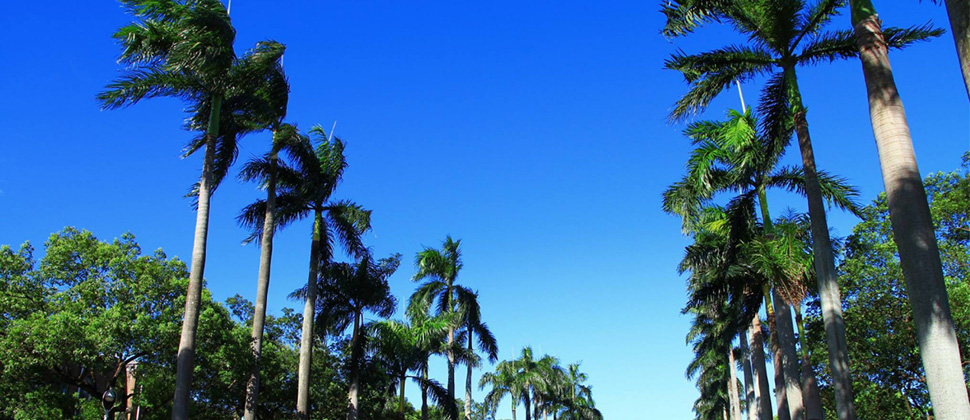

管理學院外籍交換生臺北行腳--走進龍山寺的歷史繁華
Taipei City Tour一向深受管院外籍生交換生喜愛,今年國際事務室第七年承辦,儼然成為管院重要的迎新傳統之一。事實上,無論帶這群學生走訪哪些景點、參觀哪些建築,其目的無非在於幫助這群剛抵達臺灣的外國人能快速的認識這塊土地,以期未來他們能憑己力去探索臺灣的其他角落。
2017年2月17日下午,一群興奮的外籍生和管院接待志工一同搭上遊覽車,當周遭的景色逐漸由熟悉的臺大校園轉為陌生的街道,約莫二十分鐘的車程,映入眼簾的換成今日的主要景點--龍山寺。古色古香的龍山寺承載著歷史的記憶、信仰的力量,她靜靜的矗立於繁華的街道間,如同下凡的神明,守護著臺北城。
龍山寺四周的圍牆掛滿整片黃色的燈籠,宏偉而美麗的呼應著剛過去的元宵節。在龍山寺周圍的街道漫步著,附近店家炊煮的香氣撲鼻而來,引誘著午後人們空蕩蕩的胃。偶爾,清香的藥草味竄進鼻腔,使人心肺一陣沁涼,萬華的街道集結著新與舊、動與靜、繁華與凋零,在臺北灰暗單調的水泥叢林中形成自己一種獨有的風格與步調。
一行人在剝皮寮歷史街區的入口停下腳步,望著巷內磚紅的矮房與寧靜祥和的氛圍,實在難以參透眼前這條小巷何以被冠上「剝皮寮」這般駭人的名稱。經導遊的講解,才明白這條不起眼的巷子在過去曾是木材加工的重鎮;街道兩側精緻的洋房原為去除樹皮的工廠,也因此獲得「剝皮寮」的稱呼。 放下心中的疑惑與害怕,大夥拿起相機盡情地擷取剝皮寮的風華,一張張的相片像塵埃,層層疊疊記述著流經剝皮寮的那段繁華年歲。
繞回龍山寺,裊裊的香煙瀰漫在擁擠的人潮中,經文的朗誦悠悠地旋繞在耳邊,在導遊的帶領下,外籍生紛紛拿起三炷香,隨著導遊的指引虔誠地向寺廟裡的眾神參拜,每個人自然而然地收起嘻笑,懷著敬畏的心,融入龍山寺發散出的虔敬氛圍。世世代代的人們走進龍山寺的殿堂,或訴說內心的苦悶,或希冀神明的眷顧;在他們的心中,龍山寺似乎超越了信仰與文化,擁有如同母親一般,飽經風霜卻依然堅毅而美麗的容顏。
參觀完龍山寺,一行人轉往華西街探索蛇類料理的秘密。外籍生大膽地嘗試了蛇類的飲品,體驗華西街特殊的飲食文化,接著又前往艋舺電影場景 -- 古山園旅社參訪。古樸的旅社保留著許多臺灣早期的電影海報,外籍生熱情地操著生澀的中文向老闆娘打招呼,老闆娘也以殷勤地回應來歡迎我們的到訪,濃濃的人情味在小小的空間中流動著,短暫的半日遊也在彼此的笑聲中畫下了句點。然而,對於龍山寺的美好印象,將如同廟柱上精緻的雕刻,永恆存在。
(文:會計三 陳芃雅、國企二 陳昱安)
Longshan Temple City Tour: A Walk Through HistoryFrom our view through the tour bus windows, the modern images of NTU seemed to fade into the timeworn surroundings of old Taipei and the Longshan Temple area (龍山寺). A place embedded in historical memory and religious faith, this temple is situated amongst the bustling streets of downtown, a silent sentinel guarding the traditions of the gods against its ever-changing environment.
As we entered the temple, we saw walls adorned with brightly colored lanterns, a reminder of the Lantern Festival that took place just a few days prior. Appetizing smells wafted over from the nearby restaurants to tickle our taste buds. Once in a while, we could smell Chinese incense and herbs refreshing the air. The streets of Wanhua is where the old meets the new, where movement and stillness collides and where the flourishing coexist with the decaying. In the concrete jungle of Taipei, Wanhua seems to speak its own language.
We stopped at Bo-Pi-Liao Historical District (剝皮寮) to admire the short red brick houses and its strangely quiet atmosphere, wondering to ourselves what purpose the place may have served in the fading past. Who knows – its eerie name translates to “skin-removing-shack.” The tour guide explained that the area used to be a major wood processing township, pointing out to the two elaborate looking buildings which used to serve as factories. The name was a reference to the process of tree bark being peeled off the logs that passed through its factories. Finally waving away our fears and doubts, we became eager to capture all of its fading glory on our cameras.
Inside Longshan Temple, the smell of incense drifted between the crowds of worshippers and the sound of mantra-chanting echoed in the background. Generations after generations have walked the floors of Longshan Temple with wishes reserved only for the gods to hear. The tour guide taught the exchange students how to properly hold the incense and led them around for prayers, introducing each god on the way. We soon found ourselves with smiles and imitated the rest of the crowd in quiet reverence. In the people’s hearts, Longshan is beyond a mere temple for religious faith, but a place with the same kind of strength and beauty of a loving mother.
Near the end of our tour, we departed for the nearby Snake Alley (華西街) to test out its famous snake cuisine. Many exchange students had their first taste of snake blood drinks. We then visited Gu Shan Yuan Hotel (古山園旅社), as featured in the popular Taiwanese movie “Monga.” The historical hotel still had a few well preserved old movie posters on display. Greeted enthusiastically in Chinese by the exchange students, the hotel owner greeted us back with equal enthusiasm. Our half day tour came to an end there, with smiles on all of faces and fond memories of Longshan Temple. We hope that these memories will endure just as the elegant carvings on the pillars of Longshan Temple have endured.






